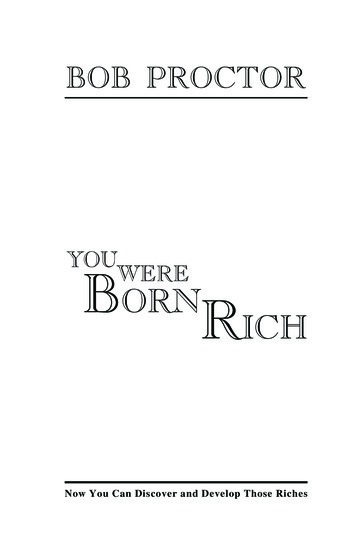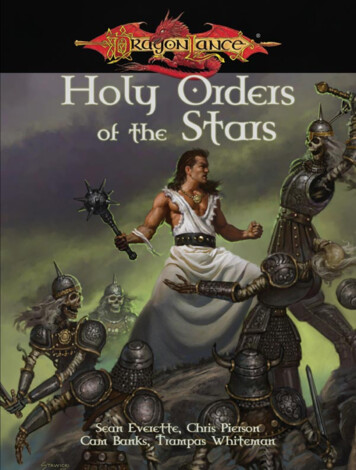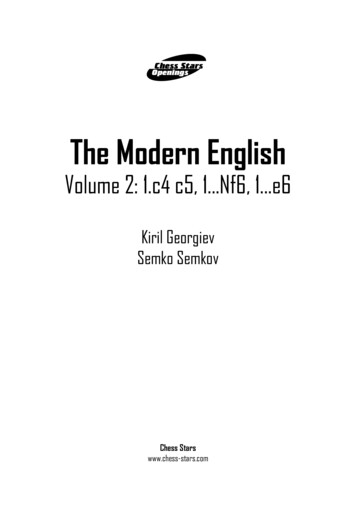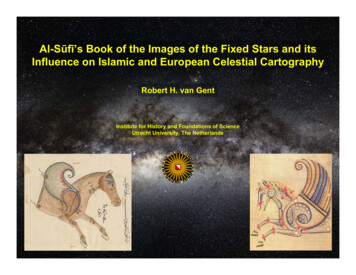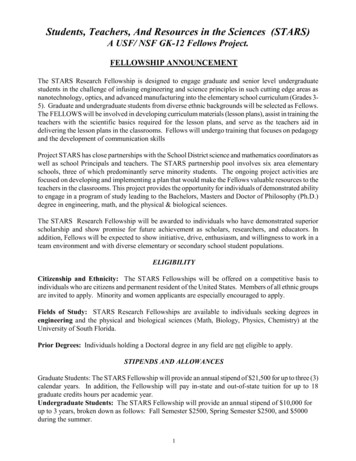
Transcription
STARS: how they are born, live and die[Image from “Gravity’s fatal attraction” by Begelman & Rees]
HOW STARS ARE BORN[Image from http://soral.as.arizona.edu/submm-science.html]
STAR BIRTH CLOUDS IN M16[Image by the HubbleTelescope - NASA]
HOW STARS LIVE AND DIEThe life and death ofLOW-MASS STARS (i.e. our beloved Sun)
The life and death of a low-mass starStart with a normal star like the Sun. Fusion ofprotons into helium in the star’s center generatesheat and pressure that can support the weight ofthe star. The Sun was mostly made of hydrogen( 1 proton 1 electron) when it was born, andstarted with enough hydrogen to last like this forabout 15 billion years.[This and next five slidescourtesy of D. Watson witha few modifications]
The life and death of a low-mass star (cont.)When it begins to run out of hydrogen in itscenter, not enough heat and pressure aregenerated to balance the star’s weight, sothe core of the star gradually begins tocollapse.
The life and death of a low-mass star (cont.)As the core collapses it gets hotter, though no extraheat has been generated, just because it compresses.It gets so hot that light from the core causes theouter parts of the star to expand and get less dense,whereupon the star looks cooler from the outside.The star is becoming a red giant.
The life and death of a low-mass star (cont.)Eventually the core gets so hot that it is possible forhelium to fuse into carbon and oxygen. Extra heatand pressure are once again generated and the corestops collapsing; it is stable until the helium runs out,which takes a few million years. The outer parts ofthe star aren’t very stable, though.Matterflowing awayfrom the star
The life and death of a low-mass star (cont.)Eventually the core is all carbon and oxygen, noadditional heat and gas pressure is generated, andthe core begins collapsing again. This time thedensity is so large – the electrons so close together –that electron degeneracy pressure begins to increasesignificantly as the collapse proceeds.Matterflowing awayfrom the star
The life and death of a low-mass star (cont.)Electron degeneracy pressure eventually brings thecollapse of the core to a halt, before it gets hotenough to fuse carbon and oxygen into magnesiumand silicon. The unstable outer parts of the star fallapart altogether; they are ejected and ionized bylight from the core, producing a planetary nebula.
Hubble images of PLANETARY NEBULAE[Images by theHubble Telescope- NASA]
The life and death of a low-mass star (cont.)The planetary nebula’s material expands awayfrom the scene in a few thousand years, leavingbehind the hot, former core of the star, nowabout the size of Earth. Its weight supportedagainst further collapse by electron degeneracypressure, it will do nothing but sit there and cooloff, for eternity.[This and next slide courtesy of D. Watson]
The life and death of a low-mass star (cont.)When brand new, this degenerate star is quite hotand looks white (like Sirius B) or even blue incolor, leading to the name white dwarf. Theoldest “white dwarfs” in our galaxy, age about 12billion years, have had enough time to cool downto temperatures in the few thousands of degrees,and thus look red. (Despite this they are still calledwhite dwarfs.)
A famous white dwarf: Sirius BDistance to us 8.7 light yearsDensity 50,000 times that of waterSirius BSirius AChandra X-ray Observatory image (NASA/CfA)
Funky properties of white dwarf material1 Kg chocolate cake2 Kg chocolate cake0.4 Msun white dwarf0.8 Msun white dwarf
How heavy can a white dwarf be?Subrahmanyan Chandrasekar.CHANDRASEKAR LIMIT: 1.4 MSUNA star heavier than 1.4 Msun can no longer be supported againstgravitational collapse by the degeneracy pressure of electrons.
Experimental confirmation of Chandrasekhar’stheory of white dwarfsT oday thousands of white dwarf stars are known. Sure enough,all stellar masses under 1.4 M are represented, but no whitedwarf heavier than this has ever been found.For this work, Chandrasekhar was awarded the 1983 Nobel Prizein Physics. The NASA Chandra X-ray Observatory (CXO) isnamed in his honor.Seven white dwarfs(circled) in a small sectionof the globular cluster M4(By H. Richer and M. Bolte.Left: Kitt Peak NationalObservatory 36”; right:Hubble Space Telescope).[Slide courtesy of D. Watson]
HOW STARS DIEHIGH-MASS STARSNuclear reactions proceeduntil core becomes Iron.Core collapses until densitybecomes so high that neutronsare packed very tightly andtheir degeneracy pressuresupports against gravityNEUTRON STARNeutron degeneracy pressureprevents further collapseMmax 2-3 Msun[Image from “Gravity’sFatal Attraction” byBegelman & Rees]
The explosion is dramatic: SUPERNOVA . as seen by an artist
as seen by a telescope[Supernova 1987A, Anglo-Australian Observatory]
What is left behind: SUPERNOVA REMNANT[Images from the Chandra Observatory]
The Crab supernova remnant seen at different wavelengthsX-raysOptical[NASA/CXC/SAO][Palomar /NSF]Radio[VLA/NRAO]
NEUTRON STAR propertiesMount EverestNeutron StarWeight of a neutron starPinhead ofSize of aneutron star
How neutron stars manifest themselves:PULSARSA pulsar is a magnetized,spinning neutron star thatemits a beam of radiation(mostly radio, but alsoX-ray and optical). Asthe star spins, its beamsweeps around.Any time the beam sweepsby the Earth, telescopesdetect a pulse of radiation.
How does a pulsar “sound”?The Arecibo radio telescope[Audios courtesy of D. Nice]
What happens if the Iron core of the collapsingstar has a mass larger than 2-3 Msun?A BLACK HOLE IS BORN![Image from /hole.born.gif]
QUESTIONS TO BE ADDRESSED:Where are these remnant black holes?Can we identify them? How?What are the observational signaturesthat allow us to distinguish a black holefrom another remnant such as a neutronstar?Are the stellar remnant BHs the only types ofblack holes in our Universe?
HOW STARS LIVE AND DIE The life and death of LOW-MASS STARS (i.e. our beloved Sun) Start with a normal star like the Sun. Fusion of protons into helium in the star’s center generates heat and pressure that can support the weight of the star. The Sun was mostly made of hydrogen ( 1 proton 1 electron) when it was born, and started with enough hydrogen to last like this for about 15 billion .

